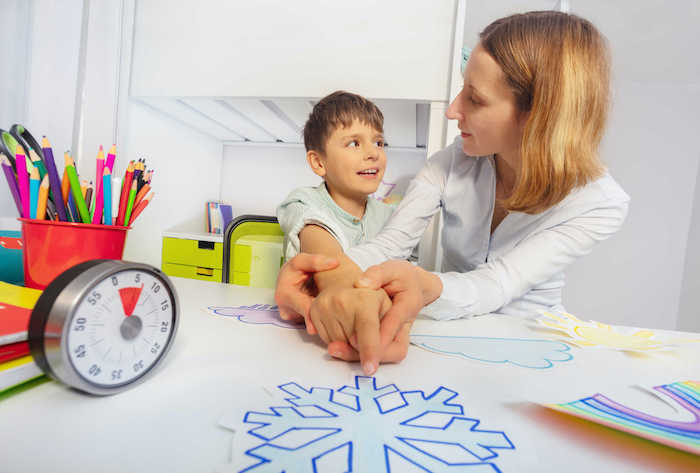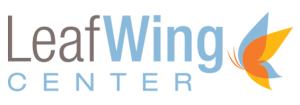ABA therapy in Glendale, AZ
LeafWing Center offers Applied Behavioral Analysis therapy in Glendale, AZ. We also provide therapy in homes, schools, and various locations throughout western Arizona. Our focus is on individuals diagnosed with Autism Spectrum Disorder (ASD). Applied Behavior Analysis (ABA) therapy is a scientifically proven technique that we use to treat individuals with ASD and other developmental disabilities. ABA therapy relies on respondent and operant conditioning to change behaviors of social significance. Our ultimate goal is to help individuals gain independence by learning and developing new skills. This leads to an increase in positive behavior and a decrease in negative behavior. Our ABA programs are tailored to each individual’s unique needs. Families and learners can expect personalized and effective ABA therapy in Glendale, AZ.

What is ABA therapy used for in Glendale, AZ?
ABA therapy is versatile and can be used for various diagnoses and areas of need. In Glendale, AZ, LeafWing Center offers ABA therapy primarily for individuals with autism. This therapy helps teach specific skills that may be missing from the individual’s repertoire. The goal is to improve their functioning at home, school, and within the community. ABA interventions can also address behavioral excesses like tantrums or aggression. Furthermore, ABA therapy provides training for parents or caregivers. Unlock the potential of individuals with autism through our practical and comprehensive ABA therapy programs at LeafWing Center.
How to get started with Leafwing Center’s ABA therapy for autism in Glendale, AZ
Contact LeafWing Center to schedule an assessment. Once the assessment is done and your funding source approves ABA services, we’ll assign a dedicated team for your child. This team will include a Supervisor and skilled Behavior Technicians. You’ll receive a monthly schedule of services in advance. To ensure the best fit for your loved one’s needs, our ABA provider will contact you for your availability and create a personalized schedule. Get ready for a transformative journey with LeafWing Center!

Insurance coverage for ABA therapy in Glendale, AZ
LeafWing Center works with an ever-growing list of insurance providers offering ABA therapy coverage to treat autism. We accept insurance coverage from a whole host of other providers. Below is a non-exclusive list of the insurance providers we currently work with:
- Aetna
- Ambetter from Arizona Complete Health
- Anthem Blue Cross of California
- Arizona Complete Health (formerly Health Net of AZ) (HMO)
- Banner Health and Aetna Health Plan Inc. (HMO)
- Banner-University Family Care
- Beacon Health Options
- Beacon Health Strategies
- Blue Cross Blue Shield of AZ (HMO & PPO)
- Care1st Health Plan
- CIGNA
- Cigna Healthcare of AZ (HMO)
- Comprehensive Care Corp./Advanzeon Solutions Incorporated
- Comprehensive Behavioral Care Incorporated
- Health Choice Arizona
- Health Plus aka Multiplan
- Imperial Insurance Companies, Inc. (HMO)
- Magellan
- Magna Care aka Multiplan
- Medica
- MHN Managed Health Network Incorporated
- Molina Healthcare of California
- Magna Care aka Multiplan
- Managed Health Network Incorporated aka MHN
- Medica
- Medica Community Health Plan (HMO)
- Meritain Health
- Mercy Care
- Molina Healthcare
- Optum UBH
- Optum Health Behavioral Solutions
- Oscar Health Plan, Inc. (HMO)
- Pacific Care Behavioral Health
- SCS-UBH aka Optum/UBH
- United Behavioral Health (UBH)
- United Medical Resources
- United Health Care (UHC)
- United Health Care of Arizona, Inc. (HMO)
- United Health Care Community Plan
- Windstone Behavioral Health
LeafWing Center staff is happy to work with you to help determine if your insurance provides coverage for our ABA therapy services.

ABA therapy and initial assessments for children with autism in Glendale, AZ
A child’s skills are assessed at the beginning in skill acquisition programs. We look at communication, self-help, social skills, and motor skills. Once we identify the skills to teach, we develop goals for each. Then, we use ABA-based techniques to teach these essential skills. Our therapy program is effective because it helps the child maintain what they’ve learned over time. We also see the child applying their skills in different situations. These concepts are vital in our therapy program in Glendale, AZ.
Social communication and interaction
A child or adult with autism spectrum disorder may have the following problems with social interaction and communication skills:
- Fails to respond to his or her name or appears not to hear you at times
- Resists cuddling and holding and seems to prefer playing alone, retreating into his or her world
- Has poor eye contact and lacks facial expression
- Doesn’t speak or has delayed speech, or loses previous ability to say words or sentences
- Can’t start a conversation or keep one going, or only starts one to make requests or label items
- Speaks with an abnormal tone or rhythm and may use a singsong voice or robot-like speech
- Repeats words or phrases verbatim but doesn’t understand how to use them
- Doesn’t appear to understand simple questions or directions
- Doesn’t express emotions or feelings and appears unaware of others’ feelings
- Doesn’t point at or bring objects to share interest
- Inappropriately approaches a social interaction by being passive, aggressive, or disruptive
- Has difficulty recognizing nonverbal cues, such as interpreting other people’s facial expressions, body postures, or tone of voice
In behavior management, we first assess the challenging behaviors to determine why they occur. This helps us understand the function behind the behavior. Then, we develop a therapy program based on Applied Behavior Analysis (ABA) to decrease the behavior’s occurrence and teach the child socially appropriate alternatives. For instance, if a child throws tantrums when denied a specific item, we teach them to accept or find an alternative. However, there comes a point where we can’t offer any more alternatives. At that point, the tantrum behavior will continue until it stops. It’s not easy for parents or caregivers to adjust to this, but research shows that the challenging behavior will improve with the consistent application of an ABA-based program.
Getting to know your Glendale, AZ, autism treatment team
At LeafWing Center, we prioritize the comfort and satisfaction of our learners, their families, and caregivers regarding their Glendale, AZ therapy team. Building rapport is crucial in the early stages of therapy, as it directly impacts the program’s success. Our dedicated staff will work hard to establish a positive relationship with your loved one. This process of building rapport is not limited to the beginning of services but continues throughout the entire program. During the first few weeks of ABA therapy, families can expect a lot of play and conversation with their children. We want your child to feel comfortable and have fun with our Behavior Technicians. By creating positive experiences, we ensure that your child associates our technicians with positivity. This approach improves learning rates and leads to more desirable outcomes.
Get ready for a powerhouse team in Glendale, AZ! Your ABA squad is all about collaboration and communication. Our Supervisor will contact you to ensure all your questions and goal preferences are handled. Plus, with your permission, we’ll connect with your child’s other superstars, like speech therapists and school teachers. Together, we’ll create an unstoppable force, all working towards the same unique goals!
One-on-one ABA therapy in Glendale, AZ, for your child with autism
Behavior Technicians typically work one-on-one with your child at your home or another location in Glendale, AZ. The sessions usually last about 2-3 hours but can be adjusted based on your schedule. During these sessions, we focus on targeting skill acquisition goals and implementing the Behavior Intervention Plan (or BIP). The skill acquisition goals cover various areas such as socialization, play, communication, and academics. Our team also works on reducing challenging behaviors and replacing them with more desirable ones through the BIP. We constantly evaluate and modify these goals and plans to ensure they are relevant and effective for your child’s progress.
What is involved in ABA therapy for autism in Glendale, AZ
Our ABA therapy program in Glendale, AZ, is just like our programs anywhere else. We offer services in Glendale to make it easy for parents or caregivers to keep treatment consistent for their children. A supervisor may observe a session throughout the month to ensure everything is going well and address any concerns. These overlaps and team meetings are essential for keeping treatment consistent, making progress, staying relevant, and communicating with everyone on your child’s ABA team. Our ABA therapy program is customizable and tailored to your child’s needs.
- ABA therapy is adaptable to meet the needs of each unique person
- Therapy can be offered in multiple settings – at home, at school, and in the community
- Teaches practical skills that have application in everyday life
- Can be offered either in one-to-one or group instruction

Our Glendale, AZ location, ABA therapy team will create an individualized program best to meet the needs of your child with autism
Every child and family is unique, and there is no one-size-fits-all approach. Our dedicated team of ABA professionals will collaborate with you to create a personalized treatment plan that meets the specific needs of your child and family. To learn more about this topic, don’t hesitate to contact your BCBA or us at info@leafwingcenter. We’re here to help!
Related Glossary Terms
Other Related Articles
- What Constitutes Effective Intervention For Individuals With Autism? The National Research Council’s Report On Effective Treatments For Autism Still Stands True
- Some Components Of A Good ABA Program For Children With Autism
Frequently asked questions about ABA therapy
What is ABA Therapy used for?
ABA-based therapy can be used in a multitude of areas. Currently, these interventions are used primarily with individuals living with ASD; however, their applications can be used with individuals living with pervasive developmental disorders as well as other disorders. For ASD, it can be used in effectively teaching specific skills that may not be in a child’s repertoire of skills to help him/her function better in their environment whether that be at home, school, or out in the community. In conjunction with skill acquisition programs, ABA-based interventions can also be used in addressing behavioral excesses (e.g., tantrum behaviors, aggressive behaviors, self-injurious behaviors). Lastly, it can also be utilized in parent/caregiver training.
In skill acquisition programs, a child’s repertoire of skills is assessed in the beginning phase of the services in key adaptive areas such as communication/language, self-help, social skills, and motor skills as well. Once skills to be taught are identified, a goal for each skill is developed and then addressed/taught by using ABA-based techniques to teach those important skills. Ultimately, an ABA-based therapy will facilitate a degree of maintenance (i.e., the child can still perform the learned behaviors in the absence of training/intervention over time) and generalization (i.e., the learned behaviors are observed to occur in situations different from the instructional setting). These two concepts are very important in any ABA-based intervention.
In behavior management, the challenging behaviors are assessed for their function in the beginning phase of the services. In this phase, the “why does this behavior happen in the first place?” is determined. Once known, an ABA-based therapy will be developed to not just decrease the occurrence of the behavior being addressed, but also teach the child a functionally-equivalent behavior that is socially-appropriate. For example, if a child resorts to tantrum behaviors when she is told she cannot have a specific item, she may be taught to accept an alternative or find an alternative for herself. Of course, we can only do this up to a certain point—the offering of alternatives. There comes a point when a ‘no’ means ‘no’ so the tantrum behavior will be left to run its course (i.e., to continue until it ceases). This is never easy and will take some time for parents/caregivers to get used to, but research has shown that over time and consistent application of an ABA-based behavior management program, the challenging behavior will get better.
In parent training, individuals that provide care for a child may receive customized “curriculum” that best fit their situation. A typical area covered in parent training is teaching responsible adults pertinent ABA-based concepts to help adults understand the rationale behind interventions that are being used in their child’s ABA-based services. Another area covered in parent training is teaching adults specific skill acquisition programs and/or behavior management programs that they will implement during family time. Other areas covered in parent training may be data collection, how to facilitate maintenance, how to facilitate generalization of learned skills to name a few.
There is no “one format” that will fit all children and their families’ needs. The ABA professionals you’re currently working with, with your participation, will develop an ABA-based treatment package that will best fit your child’s and your family’s needs. For more information regarding this topic, we encourage you to speak with your BCBA or reach out to us at info@leafwingcenter.org.
Who Can Benefit From ABA Therapy?
There is a common misconception that the principles of ABA are specific to Autism. This is not the case. The principles and methods of ABA are scientifically backed and can be applied to any individual. With that said, the U.S. Surgeon General and the American Psychological Association consider ABA to be an evidence based practice. Forty years of extensive literature have documented ABA therapy as an effective and successful practice to reduce problem behavior and increase skills for individuals with intellectual disabilities and Autism Spectrum Disorders (ASD). Children, teenagers, and adults with ASD can benefit from ABA therapy. Especially when started early, ABA therapy can benefit individuals by targeting challenging behaviors, attention skills, play skills, communication, motor, social, and other skills. Individuals with other developmental challenges such as ADHD or intellectual disability can benefit from ABA therapy as well. While early intervention has been demonstrated to lead to more significant treatment outcomes, there is no specific age at which ABA therapy ceases to be helpful.
Additionally, parents and caregivers of individuals living with ASD can also benefit from the principles of ABA. Depending on the needs of your loved one, the use of specified ABA techniques in addition to 1:1 services, may help produce more desirable treatment outcomes. The term “caregiver training” is common in ABA services and refers to the individualized instruction that a BCBA or ABA Supervisor provides to parents and caregivers. This typically involves a combination of individualized ABA techniques and methods parents and caregivers can use outside of 1:1 sessions to facilitate ongoing progress in specified areas.
ABA therapy can help people living with ASD, intellectual disability, and other developmental challenges achieve their goals and live higher quality lives.
What does ABA Therapy look like?
Agencies that provide ABA-based services in the home-setting are more likely to implement ABA services similarly than doing the same exact protocols or procedures. Regardless, an ABA agency under the guidance of a Board-Certified Behavior Analyst follows the same research-based theories to guide treatment that all other acceptable ABA agencies use.
ABA-based services start with a functional behavior assessment (FBA). In a nutshell, a FBA assesses why the behaviors may be happening in the first place. From there, the FBA will also determine the best way to address the difficulties using tactics that have been proven effective over time with a focus on behavioral replacement versus simple elimination of a problem behavior. The FBA will also have recommendations for other relevant skills/behaviors to be taught and parent skills that can be taught in a parent training format to name a few. From there, the intensity of the ABA-based services is determined, again, based on the clinical needs of your child. The completed FBA is then submitted to the funding source for approval.
One-on-one sessions between a behavior technician and your child will start once services are approved. The duration per session and the frequency of these sessions per week/month will all depend on how many hours your child’s ABA services have been approved for—usually, this will be the number recommended in the FBA. The sessions are used to teach identified skills/behaviors via effective teaching procedures. Another aspect of ABA-based services in the home-setting is parent training. Parent training can take many forms depending on what goals have been established during the FBA process. The number of hours dedicated for parent training is also variable and solely depends on the clinical need for it. If a 1:1 session is between a behavior technician and your child, a parent training session or appointment is between you and the case supervisor and with and without your child present, depending on the parent goal(s) identified. Parent training service’s goal is for you to be able to have ample skills/knowledge in order for you to become more effective in addressing behavioral difficulties as they occur outside of scheduled ABA sessions. Depending on the goals established, you may be required to participate in your child’s 1:1 sessions. These participations are a good way for you to practice what you have learned from the case supervisor while at the same time, having the behavior technician available to you to give you feedback as you practice on those new skills.
As mentioned in the beginning, no two ABA agencies will do the same exact thing when it comes to providing ABA services; however, good agencies will always base their practice on the same empirically-proven procedures.
How do I start ABA Therapy?
In most cases, the first item required to start ABA therapy is the individual’s autism spectrum disorder (ASD) diagnosis report. This is typically conducted by a doctor such as a psychiatrist, psychologist, or a developmental pediatrician. Most ABA therapy agencies and insurance companies will ask for a copy of this diagnosis report during the intake process as it is required to request an ABA assessment authorization from the individual’s medical insurance provider.
The second item required to start ABA therapy is a funding source. In the United States, and in cases where Medi-Cal or Medicare insurances are involved, there is a legal requirement for ABA services to be covered when there is a medical necessity (ASD diagnosis). Medi-Cal and Medicare cover all medically necessary behavioral health treatment services for beneficiaries. This typically includes children diagnosed with ASD. Since Applied Behavior Analysis is an evidence based and effective treatment for individuals with ASD, it is considered a covered treatment when medically necessary. In many cases, private insurance will also cover ABA services when medically necessary, however in these cases, it is best to speak directly with your medical insurance provider to determine the specifics of the coverage and to ensure that ABA is in fact, a covered benefit. Additionally, some families opt to pay for ABA services out-of-pocket.
The next step to starting ABA therapy is to contact an ABA provider whom you are interested in working with. Depending on your geographic location, ABA agencies exist in many cities across the United States. Your insurance carrier, local support groups, and even a thorough online search can help you find reputable and properly credentialed ABA agencies near you. Our organization, LeafWing Center, is based in southern California and is recognized for aiding people with ASD achieve their goals with the research based on applied behavior analysis.
Once you have identified the ABA provider with whom you wish to work, they should help you facilitate the next steps. These will include facilitating paperwork and authorizations with your funding source. Once the assessment process begins, a BCBA (Board Certified Behavior Analyst) or qualified Program Supervisor should get in contact with you to arrange times in which interviews with parents/caregivers and observations of your loved one can be conducted. This will help in the process of gathering important clinical information so that with your collaboration, the most effective treatment plans and goals can be established for your loved one. This process is referred to as the Functional Behavior Assessment (FBA) and is elaborated on in different blog posts on our website. With regard as to what can be expected once ABA therapy begins, please read our blog post titled: When You Start an ABA program, What Should You Reasonably Expect from Your Service Provider?


























